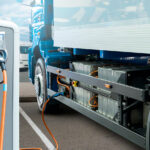Face-to-face with Karin Rådström
Face-to-face with Karin Rådström
Mercedes-Benz Trucks has just launched the new eActros 600, which can do an impressive 500km without recharging. What does the future hold for e-mobility? What about the uptake in fuel cells? Those were amongst the questions that GIANENRICO GRIFFINI put to Karin Rådström, member of the board of management, Daimler Truck AG, responsible for Mercedes-Benz Trucks.
Gianenrico Griffini: The eActros 600 celebrated its world premiere in October and will be ready for production next year. What does this truck represent for Daimler Truck in the electrification strategy?
Karin Rådström: For us at Mercedes-Benz Trucks it is a huge step on our electrification journey, as we will electrify the long-haul segment with the eActros 600. That’s the most important one – both in terms of the market but also in terms of running a high number of kilometres. It’s the biggest opportunity to reduce CO2 emissions and to improve the sustainability of road freight transport. Of course, we also hope and expect that we will set a new standard with this innovative product. The high battery capacity of more than 600kWh – hence the model designation 600 – and a new, particularly efficient electric drive axle developed in-house, enable the e-truck to achieve a range of 500km without intermediate charging.

What kind of mix do you see in the long-haul segment between the battery and the fuel cell electric?
That is the million-dollar question (laughs). We do develop fuel cell trucks in parallel, as you know. We think, from today’s point of view, that it’s a slightly less mature technology and to build up the hydrogen infrastructure might take a bit longer, which is why we plan to introduce the series version of the Mercedes-Benz GenH2 Truck in the second half of the decade. But we still think that both technologies – battery and hydrogen – will play together in the long term. They do make sense for different applications, also depending on the needs of our customers in terms of infrastructure. It might be the case that we will see quite a big span in terms of electricity costs and hydrogen costs across countries within Europe. Therefore, the total cost of ownership (TCO) might differ between regions and markets. Thirdly, there is the need to build up both infrastructures; there is not enough green electricity for the whole fleet on the road, so hydrogen will be needed, as well.
The split – how many battery-electric and how many fuel cell trucks – is obviously very difficult to predict. We are developing both in parallel, so we will be ready to balance that, depending on how the market evolves.

When I was in the US for the capital market day, I was told the expected adoption rate in Europe for the heavy-duty sector is about 10% in 2025 and up to 60% in 2030. Those are very ambitious targets. Do you expect a long, slow uptake rate and then an exponential one for zero emission vehicles?
Those approximations are based on when the TCO is better for a battery-electric or a hydrogen truck compared to a conventional truck. This of course is also very dependent on the infrastructure built up. That has obviously started a bit slower than we would have liked, which explains why the take up rate of electric trucks thus far has been a bit slower than many had thought. But we do also see a lot of initiatives on the infrastructure build-up. I think there is a chance that it will start to exponentially take off, because as you know our customers are very TCO-driven. So when the TCO makes sense and of course when our customers have built enough trust, they feel they can depend on the electric truck, in the same way they do with our current technology, so it can then go quite fast.
You say you have a holistic approach to electrification: not just a truck but also the service around it, the infrastructure, and so on. Is that working so far to convince your customers to trust in electric trucks?
We have our eConsulting offer in the market, where we work together with the customers, both to identify which use cases make sense and to check how routes could be changed in order for them to work with an electric truck. Our eConsultants also help our customers, especially the smaller ones, on the subsidy side, to identify what’s available and how to apply.
We have a huge span of customers. I have met customers who are extremely progressive, who ask for more variants and more different kinds of electrified trucks and are basically ready to change over the whole fleet. And then there are customers who still don’t believe in electrification. They are not moving at all, and they are looking at how they can rely on diesel for as long as possible. I would say it’s the whole range, which makes it kind of interesting.
The main obstacle for the introduction of electric trucks is that in Europe we have different incentives in different countries – very different subsidies for electric trucks. Would you agree with that assessment, and would you ideally prefer more or less the same level of subsidies in Europe?
Yes, that’s one part of the issue. How easy it is to apply for those subsidies also varies across Europe. For example, in one country there has been some kind of a lottery system. Customers, even when they are ready to invest, must wait for the next lottery. So actually, it can even be counterproductive to have subsidies.
In Germany, you apply as a customer and then it takes a really long time until you know if you get the subsidies or not. This slows down the process significantly. Germany might have been able to do it more easily. On the one hand subsidies are good to convince customers to take the first step. On the other hand, it’s a little bit heavy on the administration in most of the markets. That’s part of why it’s not going faster.
With the eActros 600 you have a new type of batteries compared to the first generation of the eActros 300/400 and so on. Are you going in this direction for standard high-powered batteries and are you standardising batteries?
Yes, we’ve taken that decision in terms of battery technology. This will not actually be our first truck using lithium iron phosphate (LFP) battery technology, because the eCanter already uses it, but it’s our first eActros to do so. We believe this is the best technology for trucking. But of course, we keep monitoring the developments in the industry and there can be changes in the future, because so much is happening in battery cell development. But for now, we see a lot of advantages with LFP and we will continue to develop in that direction. You can expect that for our future models, at least in the short to mid-term, we will stay with LFP technology. We think it makes sense for trucking, because these batteries have a longer service life and they also degrade less than other technologies. They are designed for 1.2 million kilometres or 10 years of service.
Do you think keeping some key technologies in-house – such as batteries or the fuel cell – is beneficial for Daimler Truck?
Yes, I do. Of course, this is the engine of the future and it’s a big part of how we can hopefully differentiate from our competitors. It’s important to understand we don’t necessarily need to do everything in-house, but I think it’s important that we work a lot to build up the competence on battery, on fuel cell, on hydrogen combustion – because we need to be able to integrate the driveline into the truck more efficiently than our competitors. So, even for the things we might not do in-house, we are building up the competence right now, to make sure we understand the technology and can make it work in our trucks. The goal is to give our customers better TCO or better efficiency than some of the competitors.
With the electrification process, are you going towards a pay-per-mile approach for trucks?
Of course we are looking into that. It gives the customer more certainty about the cost, which is even more important when you are delivering new technology. Today, a lot of our customers already do rental or leasing agreements so it’s not completely new, but we do see a shift in that direction.
Published by
Focus on Transport
focusmagsa




